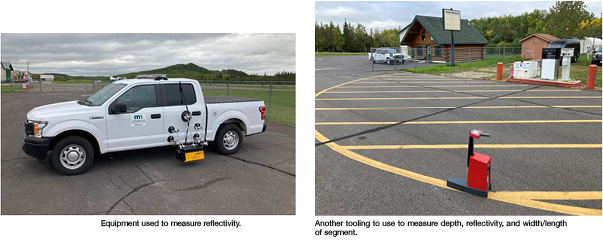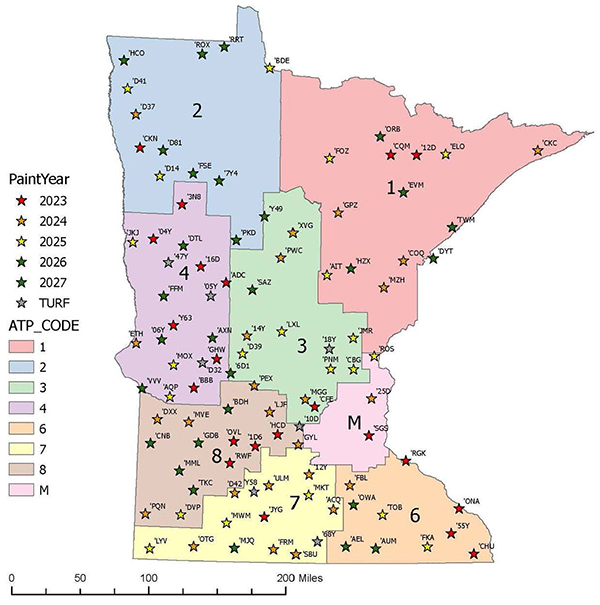by Nate Sievert
Airport Operations Program Administrator
MnDOT Aeronautics
Published in Midwest Flyer Magazine December 2023 Digital Issue
Pavement markings at airports in the state of Minnesota are refreshed and maintained through FAA standards and guidelines in FAA advisory circular 150/5340-1M. This advisory circular encompasses an entire airfield’s pavement, which includes specifications for runways, taxiways, and aprons. The Minnesota Department of Transportation holds Minnesota’s local public airports to these requirements and recommendations. The regulations are described below (in part), along with information on how MnDOT helps keep markings up to code for reliable and safe surfaces at airports.

The State of Minnesota requires that markings at all state public airports meet the FAA’s requirements and will refresh/repaint markings at those airports to meet minimum standards on a reoccurring basis.
The paint must be kept at minimal thickness for each application. If it exceeds a certain thickness over time, all layers will be removed and reapplied. The measurement of this thickness is referred to as a “mil.” The number of mils is determined through a specified formula while applying paint (wet mil) and after the paint has dried (dry mil). If too many mils are applied on a surface, the marking(s) will start to crack and adhere poorly to the pavement.

Airport pavement marking effectiveness has another important factor: marking reflectivity. To obtain reflectivity requirements, glass beads are dropped on paint markings during application and have a required amount during application to achieve initial reflectivity. The minimum requirement for reflectivity after application is lower due to expected wear and tear of a surface, yet must exceed a minimum level to meet airport safety specifications. If reflectivity drops below the specified level, it must be repainted to meet FAA requirements from Advisory Circular 150/5340-1M.

The Minnesota Department of Transportation tests the effectiveness of markings around the state through the use of reflectometers (reflectivity sensors) and aerial software. This testing aids MnDOT in making decisions on when airports need to be repainted, have a removal scheduled, and why paint is deteriorating. In addition to this, the state is taking measures to improve the process in which paint is applied and maintained at airports for safe operations.

There are many different types of pavement markings required on an airport’s paved surfaces. The types of markings vary depending on the approach systems and design categories for any given airport. Specific markings may include threshold, aiming point and sideline markings. For example, a threshold marking is required at airports with a non-precision or precision approach, but is typically not required at an airport with a visual approach.
Paint requirements are also dependent on the runway design. For example, threshold markings are required on all runways with category C or D airplanes. Additional markings may be required in certain situations on taxiways or aprons as well, where a holding position marking, or a delineating precision obstacle-free zone (POFZ) marking may be needed. Marking elements vary from airport to airport. Pilots must understand the different markings, and which ones may be present at any location a pilot may visit.
Any questions or concerns about pavement markings at state airports may be directed to nathanial.sievert@state.mn.us